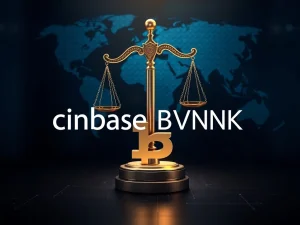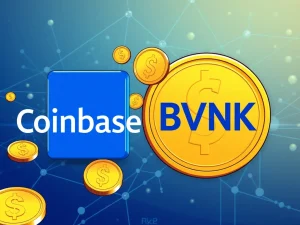Robinhood Stock Soars: Revolutionary Tokenization Strategy Unleashes Massive Gains

Are you ready for a financial game-changer? The world of brokerage is buzzing, and at its heart is Robinhood, whose stock is not just rising but soaring to near-record highs. This impressive surge isn’t just a fluke; it’s a direct result of Robinhood’s bold pivot into the future of finance: a comprehensive tokenization strategy. For anyone tracking market trends, especially those interested in the intersection of traditional finance and the digital asset space, this development offers compelling insights into where the industry is headed.
Robinhood Stock’s Phenomenal Ascent: What’s Driving HOOD?
The past few months have been nothing short of remarkable for Robinhood stock, trading under the ticker HOOD. Its shares have climbed over 27% in the past month and an astonishing 137% year-to-date, pushing its market capitalization beyond $82 billion. This isn’t merely a fleeting rally; it reflects a deeper strategic shift within the company. While a strong first quarter, boasting a 50% year-over-year revenue surge to $927 million, laid a solid foundation, the real catalyst for this accelerated growth became evident in late June.
The turning point arrived with Robinhood’s announcement of a new, tokenization-focused Layer-2 blockchain. This move signals a clear commitment to integrating advanced digital asset capabilities directly into its core offerings. For investors watching HOOD stock, this represents a significant expansion of potential revenue streams and a competitive edge in an evolving market.
Unpacking Robinhood’s Bold Tokenization Strategy
At the core of Robinhood’s recent success lies its innovative approach to tokenization. This isn’t just about offering more cryptocurrencies; it’s about fundamentally transforming how assets are traded and owned. Here’s a closer look at the key pillars of their strategy:
- Layer-2 Blockchain on Arbitrum: Robinhood has built a new Layer-2 blockchain, leveraging the robust Arbitrum network. This infrastructure is designed to facilitate the offering of tokenized US stocks and exchange-traded products (ETPs) to investors in Europe. By tokenizing these traditional assets, Robinhood aims to enhance liquidity, reduce settlement times, and potentially lower transaction costs for its international user base.
- Real World Asset Exchange (RWAX): In the United States, Robinhood has proposed the creation of the Real World Asset Exchange. This platform is envisioned as a hub for onchain settlement of Real World Assets. Imagine a world where traditional assets like real estate, commodities, or even private equity can be seamlessly traded and settled on a blockchain. This initiative could unlock significant value by making illiquid assets more accessible and transferable.
- Private Equity Token Offerings: Robinhood has ventured into offering exposure to privately held companies through tokenized products. Notable examples include offerings tied to OpenAI and SpaceX. While these are clarified as derivatives providing indirect exposure rather than direct equity, they represent a novel way for retail investors to gain access to high-growth, typically exclusive, opportunities.
This multi-pronged tokenization strategy positions Robinhood at the forefront of financial innovation, blending the accessibility of its platform with the efficiency of blockchain technology.
Navigating Regulatory Waters: Challenges and Clarifications
While Robinhood’s tokenization push has been met with investor enthusiasm, it has also attracted regulatory attention, particularly in Europe. The central bank of Lithuania, Robinhood’s primary regulator in the region, has sought more information regarding the company’s stock token offerings, specifically those linked to OpenAI and SpaceX.
Robinhood CEO Vlad Tenev has been proactive in clarifying the nature of these products. He emphasized that these are not technically equity offerings but rather derivatives that provide indirect exposure to non-public firms. This distinction is crucial, as it helps differentiate these products from traditional securities, which are subject to different regulatory frameworks. Despite the scrutiny, Tenev has noted a growing interest from other private companies seeking to make their equity accessible to investors through similar tokenized mechanisms, highlighting the market demand for such innovative financial products.
What Does This Mean for Crypto Blockchain Adoption and Beyond?
Robinhood’s success with its tokenization strategy carries significant implications for the broader crypto blockchain ecosystem. It demonstrates a powerful use case for blockchain technology beyond speculative digital currencies:
- Bridging Traditional Finance and Crypto: Robinhood is effectively acting as a bridge, making sophisticated blockchain applications accessible to a mainstream audience. This integration could accelerate the adoption of blockchain solutions in traditional financial markets.
- Democratizing Access: By tokenizing assets, including exposure to private companies, Robinhood is working to democratize access to investment opportunities that were once exclusive to institutional or high-net-worth investors.
- Innovation in Settlement: The focus on onchain settlement for Real World Assets could set a new standard for efficiency and transparency in asset transfers, potentially reducing costs and risks associated with traditional settlement processes.
This strategy could inspire other financial institutions to explore similar models, further cementing blockchain’s role as a foundational technology for the future of finance.
Beyond the Numbers: Robinhood’s Vision for Real World Assets
Vlad Tenev’s commitment to tokenization goes beyond immediate stock gains. His vision points towards a future where a wide array of Real World Assets are accessible and tradable on blockchain networks. This long-term perspective suggests that Robinhood sees tokenization not just as a feature but as a core pillar of its future growth strategy. The company’s proactive engagement with private companies to facilitate tokenized access underscores a forward-thinking approach to expanding investment opportunities.
The ongoing dialogue with regulators, while challenging, is also a necessary step in building a robust and compliant framework for these new financial products. Robinhood’s willingness to innovate while engaging with regulatory bodies could pave the way for broader acceptance and standardization of tokenized assets globally.
A Glimpse into the Future: The Impact of Tokenization
The surge in Robinhood stock is a clear indicator that the market is responding positively to its strategic embrace of blockchain and tokenization. This isn’t just about a brokerage firm performing well; it’s a testament to the transformative power of digital assets and distributed ledger technology in modern finance. Robinhood’s pioneering efforts in making tokenized US stocks available in Europe and proposing a US-based exchange for Real World Assets highlight a significant shift.
The journey, while promising, is not without its complexities, particularly concerning regulatory frameworks. However, Robinhood’s proactive stance and clarification on its offerings demonstrate a commitment to innovation within established guidelines. As the financial landscape continues to evolve, Robinhood’s tokenization strategy could serve as a blueprint for how traditional financial services can successfully integrate crypto blockchain technology to unlock new opportunities and redefine investment access for a global audience. The future of finance looks increasingly tokenized, and Robinhood is certainly leading the charge.







